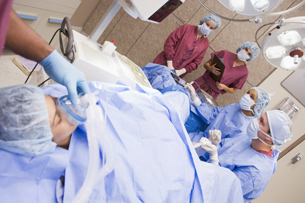Module 4
1. Module 4
1.17. Page 2
Module 4—From Fertilization to Birth
 Explore
Explore
It seems that humans are quite concerned with ensuring the right timing of fertility. The possibility of having a child when not ready has driven research into how to temporarily reduce reproductive potential. Some of the oldest research is in controlling reproductive potential.
abstinence: not having sexual intercourse; is often practised in order to prevent pregnancies and decrease the risk of transmitting or receiving STIs
barriers: any chemical or physical device that stops sperm from meeting the egg
Examples of barriers include spermicides and condoms.
contraceptive hormone treatment: birth control pills, birth control patches, and injections using estrogen-progesterone combinations to suppress ovulation, thus preventing pregnancy
Examples of technologies that reduce reproductive potential are abstinence, tubal ligation, vasectomy, physical and chemical barriers, and natural family planning. Contraceptive hormone treatment, another technology that reduces the possibility of conception, was used by Maria when she began taking birth control pills, and then again when both she and José were placed on the hormone Clomid.
family planning: natural birth control that consists of avoiding sex during the fertile period around ovulation; can be tested for by a small increase in core temperature; not very effective
tubal ligation: permanent female sterilization in which the Fallopian tubes (oviducts) are cut and sealed to prevent further ova from passing from the ovaries to the site of fertilization
vasectomy: permanent male sterilization in which the ductus deferens are cut and sealed to prevent sperm from passing from the epididymis into the semen

© Monkey Business Images/shutterstock
Technologies that enhance reproductive potential are some of the most advanced of all the assisted reproductive technologies. Because infertility, or sterility, can happen for a wide range of reasons, and the desire for many couples and individuals to have children is so strong, much research has gone into the development of fertility-enhancing technologies. Technologies such as artificial insemination, in vitro fertilization, surrogate motherhood, ovulation test kits, and super-ovulation all assist in bringing forth new offspring.
artificial insemination: a procedure in which semen from a donor is inserted by syringe into the vagina of a receptive female; used in the case of male infertility
in vitro fertilization (IVF): a process in which multiple eggs harvested from a female are combined with sperm in the lab, and the resulting embryo is implanted into the female; used in cases of female infertility
ovulation test kits: home kits that test the urine for a surge in LH, which indicates that ovulation will occur shortly; used to time intercourse to maximize the chances of conceiving
superovulation: hormones similar to FSH are prescribed to stimulate the ovary to produce eggs more consistently
surrogate motherhood: the process by which an embryo is inserted into the uterus of a woman who will carry the fetus to term, then return the baby to the biological parents; used when a woman cannot undergo pregnancy
home pregnancy test: a urine test that indicates if HCG is present in the urine
Before conception even takes place, technologies, such as at-home fertility test kits, are available to help a couple determine their reproductive potential and determine the optimal time to try conceiving. Another technology is a home pregnancy test, which can be purchased from a drug store. A home pregnancy test measures levels of pregnancy hormone in a woman’s urine. In addition to doing a home pregnancy test, more definitive urine and blood tests should be done at a medical laboratory in order to confirm conception.

© Zsolt Nyulaszi/shutterstock
Once it is confirmed that conception has occurred, other technologies are needed to monitor the events of embryonic and fetal development. Ultrasonography is a common technology used to monitor a pregnancy. Fetal surgery is a last-resort technology used to treat certain life-threatening congenital abnormalities. Other technologies that can be used to understand genetic conditions of the fetus are cordiocentesis, amniocentesis, and chorionic villi sampling. The last two technologies will be discussed in Unit C.
amniocentesis: a fetal diagnostic technique done by inserting a syringe through the mother’s abdominal and uterine walls to extract a sample of amniotic fluid, which contains sloughed-off embryonic cells; used to karyotype the embryo and diagnose chromosome non-disjunctions, such as Down’s syndrome
chorionic villi sampling (CVS): a fetal diagnostic technique done by pinching off a small sample of chorionic villus; sample is obtained vaginally
Because chorion cells are embryonic, cells can be karyotyped to diagnose chromosomal non-disjunctions, such as Down’s syndrome.
cordiocentesis: the process of sampling fetal blood from the umbilical cord to test for the possibility of infection or blood disease
Ultrasonography: fetal diagnostic technique by which high-frequency sound waves are bounced off the fetus, providing images of internal and external fetal structures; commonly called ultrasound
Reproductive technologies can also be used in parturition. One such technology has already been discussed—delivery by Caesarian-section. Various technologies are used to assist with the birthing process itself. These include the following:
- induction medication (oxytocin drip)
- fetal heart monitor
- epidural
- episiotomy
- forceps
- suction
A reproductive technology needed shortly after childbirth is related to the Rh factor studied in Biology 20. If the mother is Rh– and the fetus being born is Rh+ , then an anti-Rh antibody is given to the mother within the first 72 hours following childbirth. The injected anti-Rh antibodies destroy any of the baby’s red blood cells that may be in the mother’s blood before the mother’s immune system produces antibodies. Timing of the injection is crucial because it must be done before the mother has started to produce antibodies.
You may choose to review these concepts by turning to page 297 of your textbook and examining "Figure 8.31."

© Ewa Walicka/shutterstock
Fertility Case Study Update
The Fertility Case Study couples have had to use a number of the reproductive technologies mentioned so far in this lesson. As the fertility doctor for the remaining two couples—Olga and Karl and Maria and José—who have not been successful in having a positive fertilization test, you now need to discuss your patients' options with them.
To explore the multitude of reproductive technologies, complete the Read and Watch and Listen activities. Record the information in a format suitable to your learning style. Ensure that you include the pros and cons of any societal issue related to the technologies that you will be reviewing.
 Read
Read
Begin your understanding of reproductive technologies by reading pages 529 to 534 of your textbook. You may also want to read the short section about the diagnosis of genetic disorders in the fetus on pages 658 and 659.
 Watch and Listen
Watch and Listen
As with any technology, advances in reproductive technologies are made quickly. Some of the information in the multimedia pieces you are about to view may not be the most up to date technologies. However, most of the information is still correct and relevant and will therefore help you to better understand some of the technologies. These videos outline the development of fetal systems during each trimester and identify the hormones and genetic factors involved in regulating fetal development. The mechanism for exchanging nutrients and wastes between the mother and fetus, and a description of the environmental influences such as alcohol and drugs are also discussed.
As review, you may choose to watch the entire video “Reproductive Technologies and Sexually Transmitted Disease: Eggs, Embryos, and Ethics”; however, concentrate on the following segments:
- “Bio Probe: Assisted Reproductive Technologies”
- “Fertility Treatments”
- “Bio Discovery: Ethics of Reproductive Technology”
- “Concept Map: Treating Infertility”
Also view “Hormonal Controls and Conception: A Reproduction Rhapsody.” This video also provides a good review of the concepts of this unit. You may watch the entire video, or you may concentrate on the section “Bio Discovery: Contraceptive Methods and Devices” and continue viewing to the end of the video. You may be required to enter a username and password in order to view the video. Contact your teacher for this information.
The "Ultrasound: How Does it Work?" gizmo outlines the development of fetal systems during each trimester and identifies the hormones and genetic factors involved in regulating fetal development. It also shows how ultrasound is used to study development, illustrates the mechanism for exchanging nutrients and wastes between the mother and fetus, and describes the environmental influences such as alcohol and drugs.
 Try This
Try This
TR 1. Work by yourself or in a group to complete "Thought Lab 15.2: Evaluating Reproductive Technologies: Safety and Effectiveness" on page 533 of the textbook.
You may choose to consult with other students and your teacher to exchange additional information and to summarize findings for all the technologies investigated. Consult with your teacher for the answers to this lab.
 Discuss
Discuss
Through your discussion board, discuss one, some, or all of the following questions.
D 1. What is your opinion about the use of technology to help mother and child bond?
D 2. How do you think North American society has been affected by the use of reproductive technologies?
D 3. A 3-D ultrasound produces a three-dimensional image of the fetus, generally in a still picture format. A 4-D ultrasound is like viewing a video tape of the fetus inside the womb. Do you think that a mother would be more inclined to practise a healthy lifestyle if she could view her baby in a 4-D ultrasound?
D 4. Can you think of a new or different type of reproductive technology that could improve any component of human reproduction?
D 5. What are the advantages and disadvantages to society when social support is provided to single parents who might need support to raise their children?
D 6. Should health care plans help compensate couples for costs related to adoption and in vitro fertilization?
 Self-Check
Self-Check
SC 1. See how well you understand reproductive technologies by completing questions 33 to 36 on pages 530 and 532 of the textbook.
 Self-Check Answers
Self-Check Answers
SC 1.
Textbook questions, pages 530 and 532
- Students should cite any two of the following reasons for male infertility: obstructions in the ductus deferens or epididymis; low sperm count; high proportion of abnormal or non-viable sperm; inability to achieve an erection or ejaculation; smoking; alcohol use, overheated testicles. Treatments can include: healthier lifestyle (cutting back on smoking, alcohol, wearing looser clothing); artificial insemination; in vitro fertilization; use of a sperm bank.
- Students should cite any two of the following reasons for female infertility: blocked oviducts; failure to ovulate; endometriosis; damaged eggs. Treatments can include artificial insemination; in vitro fertilization; surrogate mothers; superovulation.
- The most effective method to avoid conceiving a child is to practice abstinence. It not only prevents pregnancy, it also helps to minimize the risk of STIs.
- The technology that does the best job of preventing conception and protecting against the transmission of STIs is a combination of condoms (a physical barrier) and chemical barriers (spermicides in the form of jellies, foams, or creams).
Inquiry into Biology (Whitby, ON: McGraw-Hill Ryerson, 2007), TRM 530–532. Reproduced by permission.